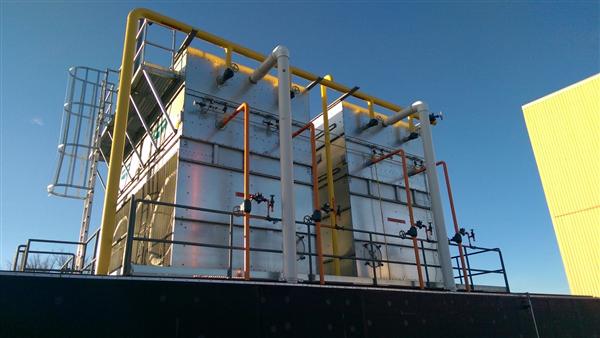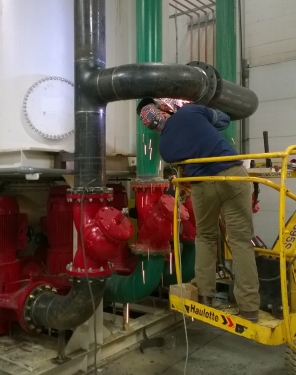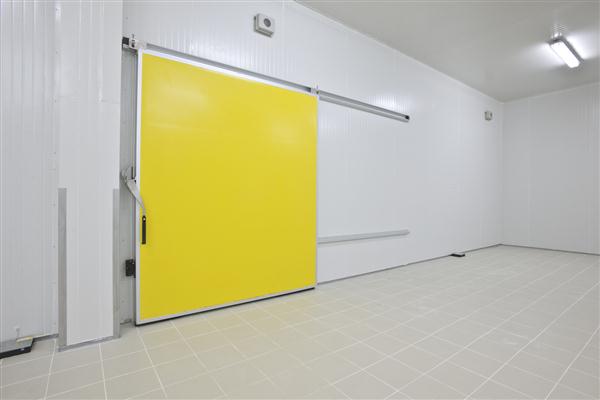Food Processing Refrigeration Systems
For Food Processing Facilities, Manufacturing Plants and Distribution Centers
 Discovery Designs Refrigeration is an industry leader in the custom design and installation of industrial refrigeration systems for food processing facilities, manufacturing plants, and distribution centers in the United States. Industrial refrigeration systems are essential for ensuring the quality and safety of food products. CO2 and Ammonia-based refrigeration systems are the most common in the food processing industry, offering high-efficiency and reliable performance. Contact the refrigeration experts at Discovery Designs Refrigeration today for a free quote!
Discovery Designs Refrigeration is an industry leader in the custom design and installation of industrial refrigeration systems for food processing facilities, manufacturing plants, and distribution centers in the United States. Industrial refrigeration systems are essential for ensuring the quality and safety of food products. CO2 and Ammonia-based refrigeration systems are the most common in the food processing industry, offering high-efficiency and reliable performance. Contact the refrigeration experts at Discovery Designs Refrigeration today for a free quote!
CO2 & Ammonia Industrial Refrigeration Systems
Discovery Designs Refrigeration designs CO2 and Ammonia-based industrial refrigeration systems. Ammonia-based refrigeration systems are among the most popular for food processing facilities, largely due to the minimal space requirements compared to CO2-based systems. Both Ammonia and CO2-based systems are highly efficient and reliable when installed properly. CO2-based systems are often used in food processing facilities that utilize freezer applications as they perform extremely efficiently at low temperatures. Not sure which system is right for your facility? Give us a call to discuss the ideal refrigeration type for your facility and operations.
High-Quality Designs & Custom Engineered Solutions
Blending innovative engineering with decades of industry experience, Discovery Designs Refrigeration offers comprehensive industrial refrigeration solutions. Taking into consideration your facility’s unique specifications and operational requirements, our team of engineers and refrigeration specialists will work closely with you to design the ideal refrigeration system for your needs. Whether you are building a new facility and want to start from scratch, or you are looking to retrofit an existing facility, trust the industrial refrigeration design experts at Discover Designs Refrigeration for complete solutions.
Retrofitting and New Installation
 If your old refrigeration system is constantly in need of repair or operating inefficiently, it may be time for a retrofit or replacement. Our engineering team specializes in both new installations and retrofitting existing systems to modern standards. We carefully evaluate your current setup, energy consumption, and operational needs to recommend the most cost-effective solution. Whether upgrading components or installing an entirely new system, we ensure minimal disruption to your operations while implementing refrigeration solutions that enhance productivity and reduce energy costs. Our retrofit projects consistently result in significant improvements in system reliability, efficiency, and compliance with current industry standards.
If your old refrigeration system is constantly in need of repair or operating inefficiently, it may be time for a retrofit or replacement. Our engineering team specializes in both new installations and retrofitting existing systems to modern standards. We carefully evaluate your current setup, energy consumption, and operational needs to recommend the most cost-effective solution. Whether upgrading components or installing an entirely new system, we ensure minimal disruption to your operations while implementing refrigeration solutions that enhance productivity and reduce energy costs. Our retrofit projects consistently result in significant improvements in system reliability, efficiency, and compliance with current industry standards.
Pipefitting
Proper pipefitting is crucial for industrial refrigeration system performance and safety. Our expert pipefitters bring extensive experience in ammonia and CO2 refrigeration systems, ensuring all piping is installed to exact specifications. We follow rigorous industry standards for welding, pressure testing, and insulation to guarantee system integrity and optimal refrigerant flow. From small repairs to complete system installations, our pipefitting expertise ensures your refrigeration system operates at peak efficiency.
Blast Freezers
 Industrial blast freezers rapidly reduce product temperature to maintain quality, texture, and shelf life in food processing operations. We design and install custom blast freezing systems optimized for your specific products and throughput requirements. Whether you need spiral, tunnel, or batch blast freezers, our solutions incorporate advanced airflow design and temperature control systems to ensure consistent, energy-efficient freezing across your production line.
Industrial blast freezers rapidly reduce product temperature to maintain quality, texture, and shelf life in food processing operations. We design and install custom blast freezing systems optimized for your specific products and throughput requirements. Whether you need spiral, tunnel, or batch blast freezers, our solutions incorporate advanced airflow design and temperature control systems to ensure consistent, energy-efficient freezing across your production line.
Insulated Metal Panels
Insulated metal panel systems provide superior thermal efficiency and moisture control for cold storage and food processing facilities. We install high-performance insulated panels engineered to maintain precise temperatures while reducing energy costs. High-quality insulated metal panels feature seamless construction, antimicrobial surfaces, and meet all FDA requirements for food-safe environments. From processing areas to cold storage rooms, we ensure proper installation and sealing for maximum thermal performance.
Food Processing Refrigeration System Contractors
In industrial freezing, industrial system refrigeration using an ammonia refrigerant system is the reliable option. It has a lower overhead cost and takes up less space than CO2 systems. As food trends change, consumers are avoiding food products using thermal treatment or preservatives. This makes careful monitoring of food temperature vital in extending food product shelf life. Food stored below -12 C eliminates the chance for bacteria, yeast, or mold to grow, extending food shelf life and ensuring food quality.
Preserve food quality:
- Appearance
- Texture
- Taste
- Nutritional contents
Storage of fruits and raw vegetables
 For fruits and vegetables, the refrigeration process begins right after harvesting to remove the postharvest heat. Fruits and vegetables are transferred in refrigerated transport to cold storage. Some may be transferred straight to the grocery stores, while other fruits and vegetables are kept in cold storage to maintain their sensory qualities.
For fruits and vegetables, the refrigeration process begins right after harvesting to remove the postharvest heat. Fruits and vegetables are transferred in refrigerated transport to cold storage. Some may be transferred straight to the grocery stores, while other fruits and vegetables are kept in cold storage to maintain their sensory qualities.
Meat
Meat requires refrigeration right after it is slaughtered, processed, and packaged. If the meat will be used in a short period of time after slaughtered, it should be kept in storage at 0 degrees Celsius. Long-term storage of meat requires to be frozen and maintained in storage at -25 degrees Celsius.
The Discovery Designs Refrigeration Difference
With decades of industrial refrigeration expertise, we deliver unmatched quality in industrial refrigeration system design, installation, and service. Our team of professional engineers and certified technicians specialize exclusively in industrial refrigeration, ensuring every project is completed to the highest standards. We pride ourselves on transparent communication, precise project management, and long-term client relationships built on trust and proven results. When you choose Discovery Designs Refrigeration, you're partnering with an industry leader committed to your success.
Industrial Refrigeration Solutions for Food Processors Nationwide
As a leading industrial refrigeration contractor, we work with food processing companies across the United States including in, Indiana, Illinois, Michigan, Iowa, Wisconsin, and beyond!


